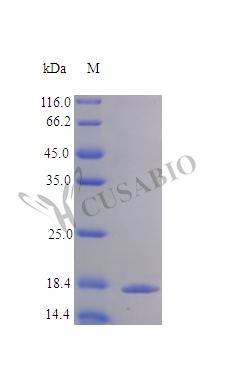We generated the recombinant human IL10 using the E.coli by expressing the plasmid that contains the gene fragment encoding the 19-178aa of human IL10. Its purity is greater than 95% as assessed by SDS-PAGE and its endotoxin level is less than 1.0 EU/μg as determined by the LAL method. This recombinant human IL10 protein has been verified to be biologically active. The ED50, measured by a cell proliferation assay with murine MC/9-2 cells, is less than 1 ng/ml, indicating a specific activity greater than 1.0x10^6 IU/mg.
Human IL10 is a crucial anti-inflammatory cytokine that regulates immune responses and maintains homeostasis within the immune system. It is primarily produced by monocytes, lymphocytes, and mast cells, and is known for its ability to inhibit the synthesis of pro-inflammatory cytokines such as TNF-α, IL-1, and IL-6 [1][2]. This inhibitory action is vital for controlling excessive inflammatory responses that could lead to tissue damage and chronic inflammatory diseases.
IL10 exerts its effects by binding to the IL10 receptor, which activates a signaling cascade involving the JAK and STAT pathways, leading to the transcription of anti-inflammatory genes and the suppression of pro-inflammatory mediators [3]. Studies have shown that IL10 deficiency can enhance Th1 and Th17 immune responses, associated with various autoimmune conditions [4].
Furthermore, IL10 has been implicated in various pathological conditions, including chronic inflammatory diseases and cancer. Its role in modulating macrophage activation and promoting a regulatory T cell phenotype is critical in conditions such as endometriosis and atherosclerosis, where inflammation plays a central role [5][6]. IL10 can influence tumor microenvironments by modulating immune cell functions, thus suppressing or promoting tumor growth depending on the context [7].
References:
[1] K. Jung, G. Lee, C. Park, T. Lee, J. Kim, E. Sunget al., Mesenchymal stem cells decrease oxidative stress in the bowels of interleukin-10 knockout mice, Gut and Liver, vol. 14, no. 1, p. 100-107, 2020. https://doi.org/10.5009/gnl18438
[2] A. Ōnishi, T. Akimoto, M. Urabe, I. Hirahara, S. Muto, K. Ozawaet al., Attenuation of methylglyoxal-induced peritoneal fibrosis: immunomodulation by interleukin-10, Laboratory Investigation, vol. 95, no. 12, p. 1353-1362, 2015. https://doi.org/10.1038/labinvest.2015.110
[3] R. Verma, L. Balakrishnan, K. Sharma, A. Khan, J. Advani, H. Gowdaet al., A network map of interleukin-10 signaling pathway, Journal of Cell Communication and Signaling, vol. 10, no. 1, p. 61-67, 2015. https://doi.org/10.1007/s12079-015-0302-x
[4] S. Wang, X. Gao, G. Shen, W. Wang, J. Li, J. Zhaoet al., Interleukin-10 deficiency impairs regulatory t cell-derived neuropilin-1 functions and promotes th1 and th17 immunity, Scientific Reports, vol. 6, no. 1, 2016. https://doi.org/10.1038/srep24249
[5] F. Idrissi, M. Fruchart, K. Bélarbi, A. Lamer, E. Dubois‐Deruy, M. Lemdaniet al., Exploration of the core protein network under endometriosis symptomatology using a computational approach, Frontiers in Endocrinology, vol. 13, 2022. https://doi.org/10.3389/fendo.2022.869053
[6] J. Xu, X. Zhang, S. Rong, H. Gao, W. Yang, J. Liet al., Yirui capsules alleviate atherosclerosis by improving the lipid profile and reducing inflammation in apolipoprotein e-deficient mice, Nutrients, vol. 10, no. 2, p. 142, 2018. https://doi.org/10.3390/nu10020142
[7] M. Lima, L. Quintans‐Júnior, W. Santana, C. Kaneto, M. Soares, & C. Villarreal, Anti-inflammatory effects of carvacrol: evidence for a key role of interleukin-10, European Journal of Pharmacology, vol. 699, no. 1-3, p. 112-117, 2013. https://doi.org/10.1016/j.ejphar.2012.11.040






